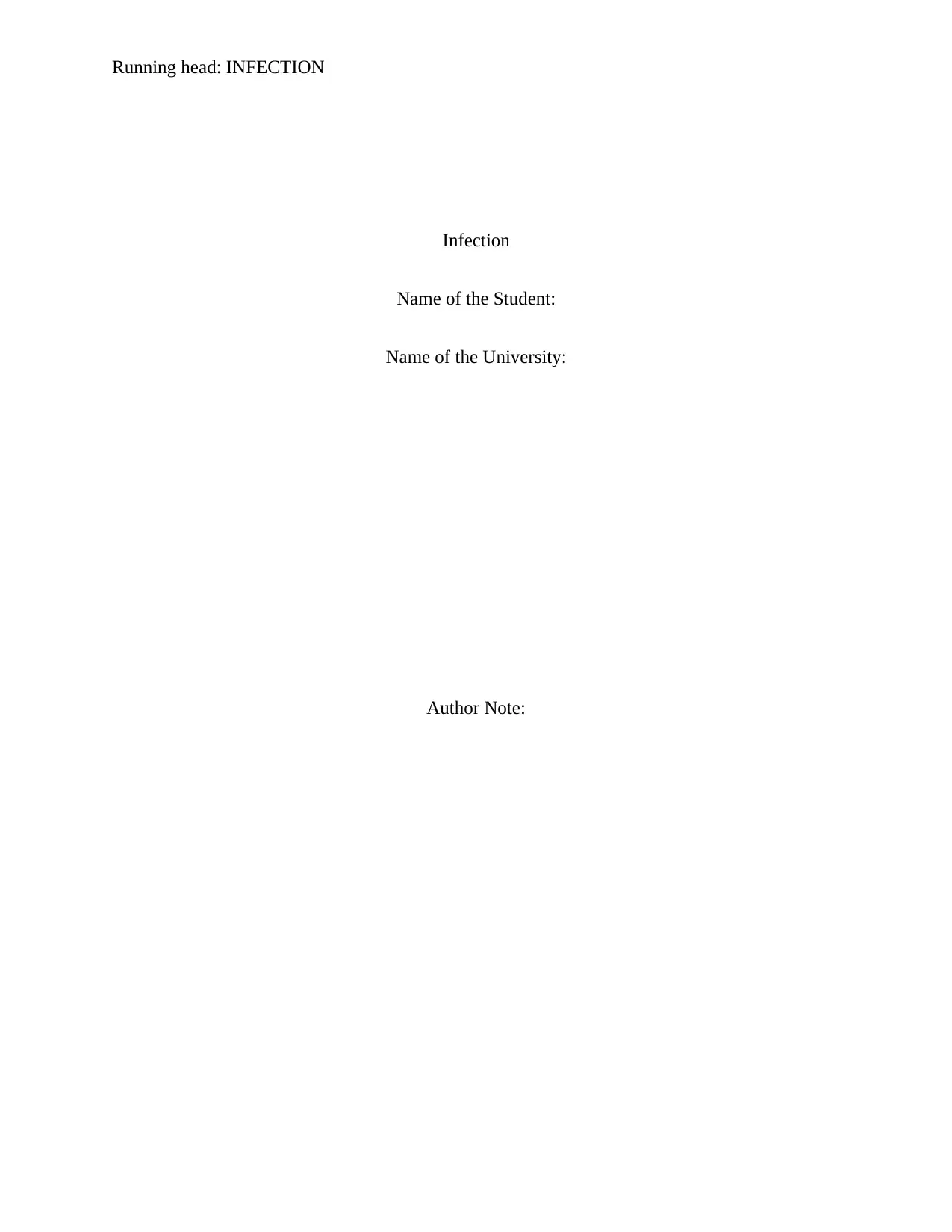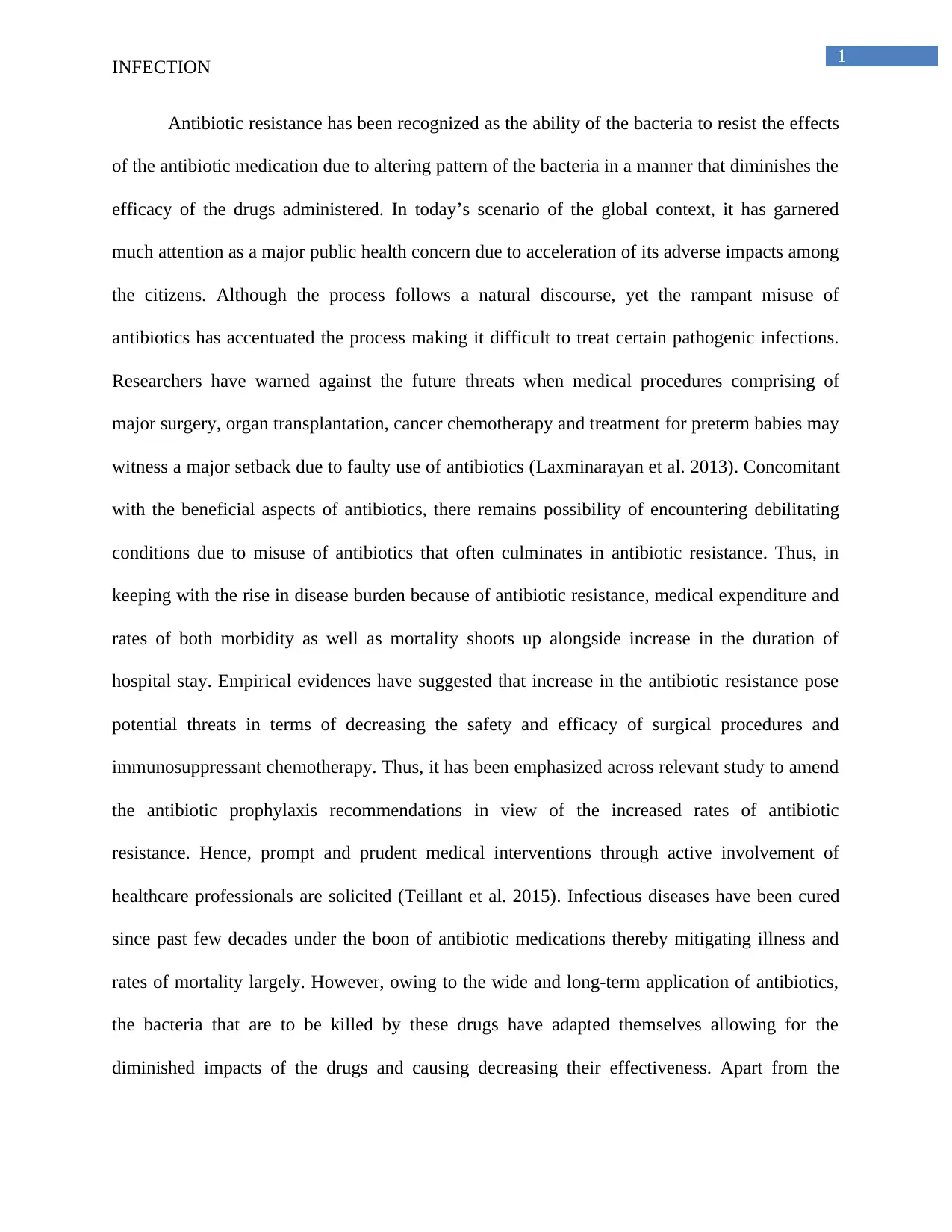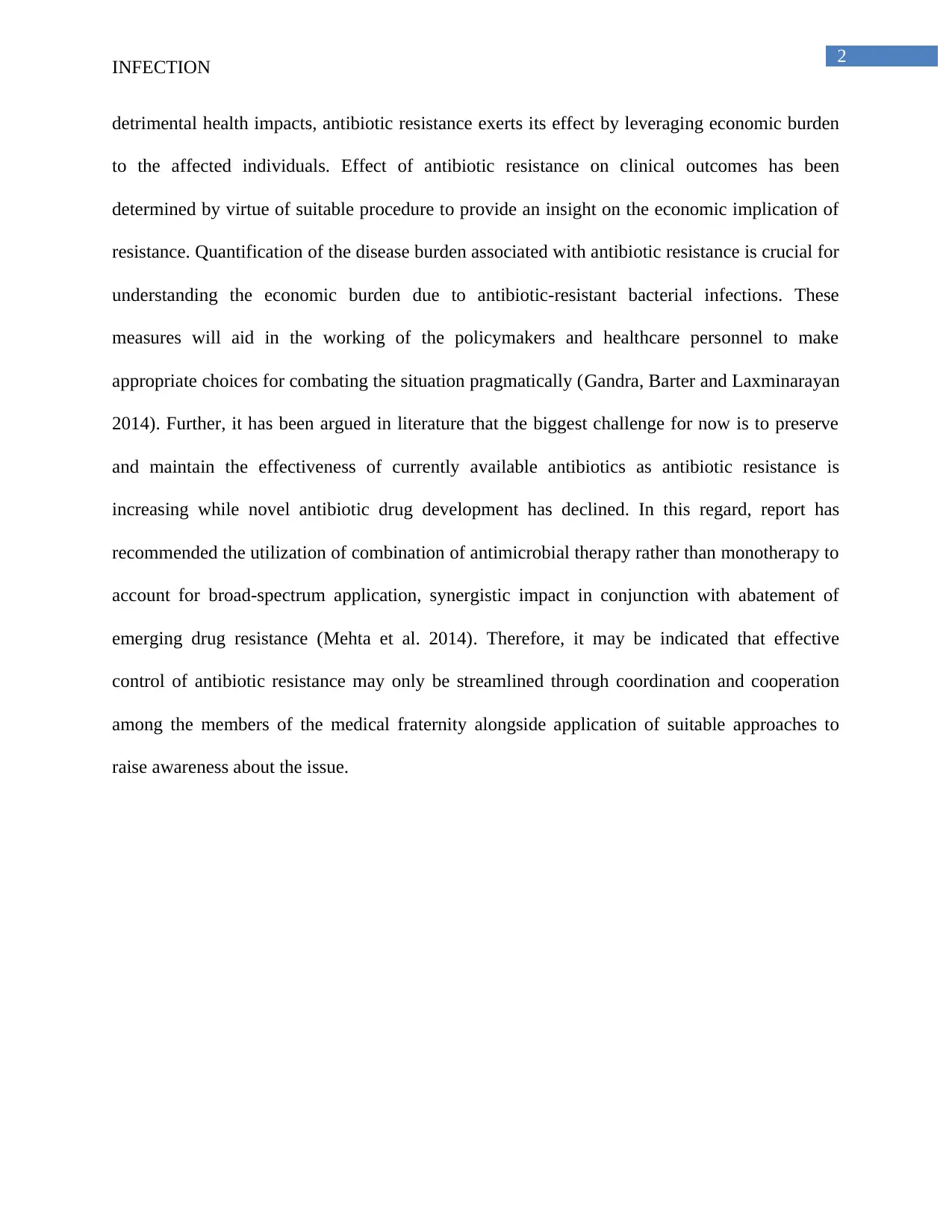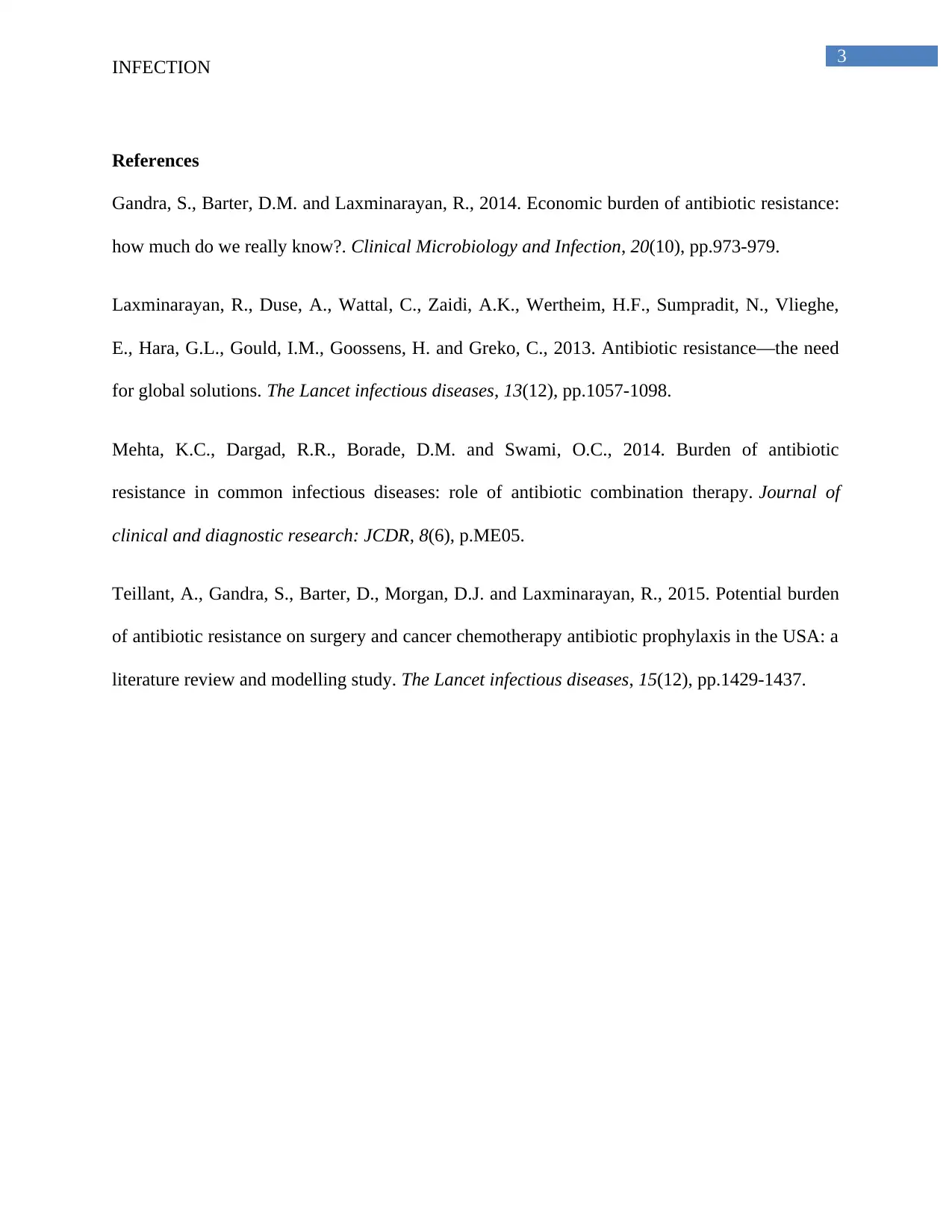Infection Report: Antibiotic Resistance, Global Health Concerns
VerifiedAdded on 2020/03/16
|4
|797
|256
Report
AI Summary
This report focuses on the critical issue of antibiotic resistance, highlighting its adverse impacts on public health globally. It discusses how the misuse of antibiotics has led to bacteria becoming resistant, making it difficult to treat infections. The report emphasizes the potential threats to medical procedures like surgery, organ transplantation, and cancer chemotherapy. It examines the economic burden associated with antibiotic resistance and the need for prudent medical interventions. The document also recommends the use of combination antimicrobial therapy to combat the issue. The report concludes by stressing the importance of coordination among medical professionals and raising awareness to effectively control antibiotic resistance. References from various sources have been used to support the analysis and findings.

Running head: INFECTION
Infection
Name of the Student:
Name of the University:
Author Note:
Infection
Name of the Student:
Name of the University:
Author Note:
Paraphrase This Document
Need a fresh take? Get an instant paraphrase of this document with our AI Paraphraser

1
INFECTION
Antibiotic resistance has been recognized as the ability of the bacteria to resist the effects
of the antibiotic medication due to altering pattern of the bacteria in a manner that diminishes the
efficacy of the drugs administered. In today’s scenario of the global context, it has garnered
much attention as a major public health concern due to acceleration of its adverse impacts among
the citizens. Although the process follows a natural discourse, yet the rampant misuse of
antibiotics has accentuated the process making it difficult to treat certain pathogenic infections.
Researchers have warned against the future threats when medical procedures comprising of
major surgery, organ transplantation, cancer chemotherapy and treatment for preterm babies may
witness a major setback due to faulty use of antibiotics (Laxminarayan et al. 2013). Concomitant
with the beneficial aspects of antibiotics, there remains possibility of encountering debilitating
conditions due to misuse of antibiotics that often culminates in antibiotic resistance. Thus, in
keeping with the rise in disease burden because of antibiotic resistance, medical expenditure and
rates of both morbidity as well as mortality shoots up alongside increase in the duration of
hospital stay. Empirical evidences have suggested that increase in the antibiotic resistance pose
potential threats in terms of decreasing the safety and efficacy of surgical procedures and
immunosuppressant chemotherapy. Thus, it has been emphasized across relevant study to amend
the antibiotic prophylaxis recommendations in view of the increased rates of antibiotic
resistance. Hence, prompt and prudent medical interventions through active involvement of
healthcare professionals are solicited (Teillant et al. 2015). Infectious diseases have been cured
since past few decades under the boon of antibiotic medications thereby mitigating illness and
rates of mortality largely. However, owing to the wide and long-term application of antibiotics,
the bacteria that are to be killed by these drugs have adapted themselves allowing for the
diminished impacts of the drugs and causing decreasing their effectiveness. Apart from the
INFECTION
Antibiotic resistance has been recognized as the ability of the bacteria to resist the effects
of the antibiotic medication due to altering pattern of the bacteria in a manner that diminishes the
efficacy of the drugs administered. In today’s scenario of the global context, it has garnered
much attention as a major public health concern due to acceleration of its adverse impacts among
the citizens. Although the process follows a natural discourse, yet the rampant misuse of
antibiotics has accentuated the process making it difficult to treat certain pathogenic infections.
Researchers have warned against the future threats when medical procedures comprising of
major surgery, organ transplantation, cancer chemotherapy and treatment for preterm babies may
witness a major setback due to faulty use of antibiotics (Laxminarayan et al. 2013). Concomitant
with the beneficial aspects of antibiotics, there remains possibility of encountering debilitating
conditions due to misuse of antibiotics that often culminates in antibiotic resistance. Thus, in
keeping with the rise in disease burden because of antibiotic resistance, medical expenditure and
rates of both morbidity as well as mortality shoots up alongside increase in the duration of
hospital stay. Empirical evidences have suggested that increase in the antibiotic resistance pose
potential threats in terms of decreasing the safety and efficacy of surgical procedures and
immunosuppressant chemotherapy. Thus, it has been emphasized across relevant study to amend
the antibiotic prophylaxis recommendations in view of the increased rates of antibiotic
resistance. Hence, prompt and prudent medical interventions through active involvement of
healthcare professionals are solicited (Teillant et al. 2015). Infectious diseases have been cured
since past few decades under the boon of antibiotic medications thereby mitigating illness and
rates of mortality largely. However, owing to the wide and long-term application of antibiotics,
the bacteria that are to be killed by these drugs have adapted themselves allowing for the
diminished impacts of the drugs and causing decreasing their effectiveness. Apart from the

2
INFECTION
detrimental health impacts, antibiotic resistance exerts its effect by leveraging economic burden
to the affected individuals. Effect of antibiotic resistance on clinical outcomes has been
determined by virtue of suitable procedure to provide an insight on the economic implication of
resistance. Quantification of the disease burden associated with antibiotic resistance is crucial for
understanding the economic burden due to antibiotic-resistant bacterial infections. These
measures will aid in the working of the policymakers and healthcare personnel to make
appropriate choices for combating the situation pragmatically (Gandra, Barter and Laxminarayan
2014). Further, it has been argued in literature that the biggest challenge for now is to preserve
and maintain the effectiveness of currently available antibiotics as antibiotic resistance is
increasing while novel antibiotic drug development has declined. In this regard, report has
recommended the utilization of combination of antimicrobial therapy rather than monotherapy to
account for broad-spectrum application, synergistic impact in conjunction with abatement of
emerging drug resistance (Mehta et al. 2014). Therefore, it may be indicated that effective
control of antibiotic resistance may only be streamlined through coordination and cooperation
among the members of the medical fraternity alongside application of suitable approaches to
raise awareness about the issue.
INFECTION
detrimental health impacts, antibiotic resistance exerts its effect by leveraging economic burden
to the affected individuals. Effect of antibiotic resistance on clinical outcomes has been
determined by virtue of suitable procedure to provide an insight on the economic implication of
resistance. Quantification of the disease burden associated with antibiotic resistance is crucial for
understanding the economic burden due to antibiotic-resistant bacterial infections. These
measures will aid in the working of the policymakers and healthcare personnel to make
appropriate choices for combating the situation pragmatically (Gandra, Barter and Laxminarayan
2014). Further, it has been argued in literature that the biggest challenge for now is to preserve
and maintain the effectiveness of currently available antibiotics as antibiotic resistance is
increasing while novel antibiotic drug development has declined. In this regard, report has
recommended the utilization of combination of antimicrobial therapy rather than monotherapy to
account for broad-spectrum application, synergistic impact in conjunction with abatement of
emerging drug resistance (Mehta et al. 2014). Therefore, it may be indicated that effective
control of antibiotic resistance may only be streamlined through coordination and cooperation
among the members of the medical fraternity alongside application of suitable approaches to
raise awareness about the issue.
⊘ This is a preview!⊘
Do you want full access?
Subscribe today to unlock all pages.

Trusted by 1+ million students worldwide

3
INFECTION
References
Gandra, S., Barter, D.M. and Laxminarayan, R., 2014. Economic burden of antibiotic resistance:
how much do we really know?. Clinical Microbiology and Infection, 20(10), pp.973-979.
Laxminarayan, R., Duse, A., Wattal, C., Zaidi, A.K., Wertheim, H.F., Sumpradit, N., Vlieghe,
E., Hara, G.L., Gould, I.M., Goossens, H. and Greko, C., 2013. Antibiotic resistance—the need
for global solutions. The Lancet infectious diseases, 13(12), pp.1057-1098.
Mehta, K.C., Dargad, R.R., Borade, D.M. and Swami, O.C., 2014. Burden of antibiotic
resistance in common infectious diseases: role of antibiotic combination therapy. Journal of
clinical and diagnostic research: JCDR, 8(6), p.ME05.
Teillant, A., Gandra, S., Barter, D., Morgan, D.J. and Laxminarayan, R., 2015. Potential burden
of antibiotic resistance on surgery and cancer chemotherapy antibiotic prophylaxis in the USA: a
literature review and modelling study. The Lancet infectious diseases, 15(12), pp.1429-1437.
INFECTION
References
Gandra, S., Barter, D.M. and Laxminarayan, R., 2014. Economic burden of antibiotic resistance:
how much do we really know?. Clinical Microbiology and Infection, 20(10), pp.973-979.
Laxminarayan, R., Duse, A., Wattal, C., Zaidi, A.K., Wertheim, H.F., Sumpradit, N., Vlieghe,
E., Hara, G.L., Gould, I.M., Goossens, H. and Greko, C., 2013. Antibiotic resistance—the need
for global solutions. The Lancet infectious diseases, 13(12), pp.1057-1098.
Mehta, K.C., Dargad, R.R., Borade, D.M. and Swami, O.C., 2014. Burden of antibiotic
resistance in common infectious diseases: role of antibiotic combination therapy. Journal of
clinical and diagnostic research: JCDR, 8(6), p.ME05.
Teillant, A., Gandra, S., Barter, D., Morgan, D.J. and Laxminarayan, R., 2015. Potential burden
of antibiotic resistance on surgery and cancer chemotherapy antibiotic prophylaxis in the USA: a
literature review and modelling study. The Lancet infectious diseases, 15(12), pp.1429-1437.
1 out of 4
Related Documents
Your All-in-One AI-Powered Toolkit for Academic Success.
+13062052269
info@desklib.com
Available 24*7 on WhatsApp / Email
![[object Object]](/_next/static/media/star-bottom.7253800d.svg)
Unlock your academic potential
Copyright © 2020–2025 A2Z Services. All Rights Reserved. Developed and managed by ZUCOL.




